Cretan wild flowers in April 2014
John Fielding, co-author with Nicholas Turland of Flowers of Crete, describes here a week’s walking in Crete in 2014 and the wild flowers he and the group found. This field trip was repeated in April 2016, again with John Fielding as botanical guide and organised by Heather Martin. The 2016 trip visited the same places as the earlier trip and a personal account of the second trip with new illustrations can be found here.
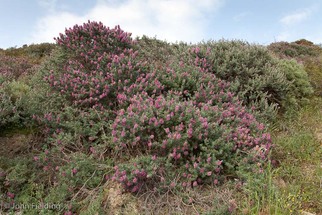
Ebenus cretica
Bituminaria bituminosa
Dracunculus vulgaris
Ebenus cretica
Euphorbia characias subsp. characias
Ornithogalum narbonense
Orobanche lavandulacea
Petromarula pinnata
Phlomis fruticosa
Pistacia lentiscus
Monday 7 April
A stroll along the beach road to the south took us to the site for Daphne gnidioides. Like the previous Orobanche it is confined to this limited area on Crete. It was not in flower as it is autumn flowering though even then it seems to be sporadic. We climbed the hill that juts out prominently into the Libyan Sea forming Cape Kakomouri. A fire had left the site open with charred black stumps
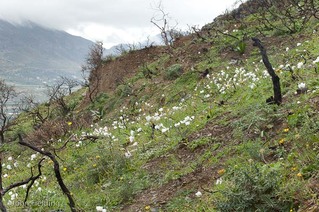
Ranunculus asiaticus
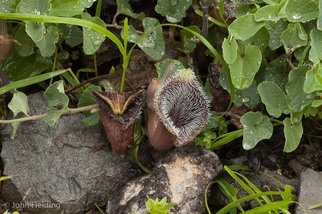
Aristolochia cretica
|
Plants noted:
Anacamptis pyramidalis Anchus italica Aristolochia cretica Asparagus aphyllus subsp. orientalis Daphne gnidioides Euphorbia acanthothamnus Euphorbia characias subsp. characias |
Euphorbia dendroides
Linaria pelisseriana Ophrys episcopalis Picnomon acarna Ranunculus asiaticus Ranunculus creticus Trifolium uniflorum Urtica pilulifera |
We visited the museum at Asomatos created by Papa Michalis Georgoulakis, now curated by his son. It is a strange but certainly interesting mix of everyday items which in most societies are typically thrown away, such as his daughters’ shoes, the family loom, home-made blankets, pots and pans, agricultural implements, children’s toys, photographs and much else, all attractively displayed. The museum is housed in what was the family home and the leafy courtyard has a pergola festooned with chandeliers.
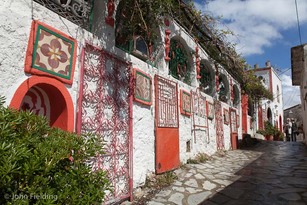
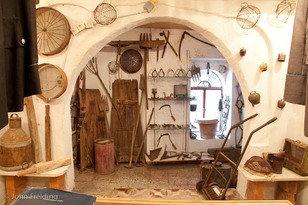
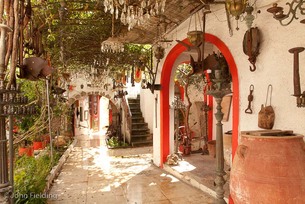
The afternoon was concluded with a gentle walk from Asomatos down the valley to the bridge at Preveli. Ecballium elaterium (squirting cucumber) was in flower but not yet in fruit at the start of the walk in the village. Large plants of the green-bracted Euphorbia characias were common along with Ferula communis (giant fennel). In the stream Veronica anagallis-aquatica (water speedwell) grew lushly alongside Nasturtium officinale (watercress). Ending up by the bridge there was a carpet of the magenta pink Malva sylvestris (common mallow) and a specimen of Styrax officinalis in full flower – elegant and pure white.
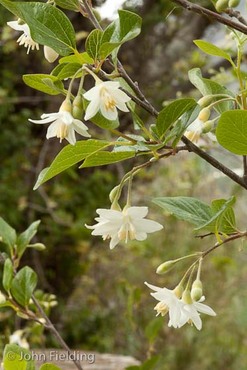
Styrax officinalis
Plants noted:
Arum concinnatum
Ecballium elaterium
Euphorbia acanthothamnus
Euphorbia characias subsp. characias
Euphorbia helioscopa
Ferula communis
Gagea graeca
Gladiolus italicus
Glebionis coronaria (syn. Chrysanthemum)
Malva sylvestris
Nasturtium officinale
Orobanche crenata
Silene gallica
Styrax officinalis
Trifolium nigrescens
Veronica anagallis-aquatica
Vicia lathyroides
Tuesday 8 April
A must for seeing a wonderful array of wild flowers is the Gious Kambos (otherwise known as “Spili Bumps”). Located above Spili it is a very easy site to access. The area consists of two distinct habitats, the fields and the surrounding rocky hillsides. The fields are famous for their tulips. The red Tulipa doerfleri was in full flower mainly around the margins of the fields. Less evident but seen was T. saxatilis, the pink-flowered species.

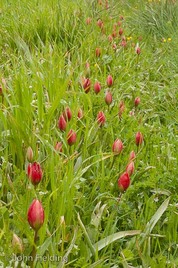
Tulipa doerfleri
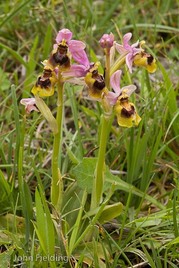
Ophrys tenthredinifera
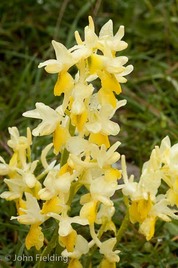
Orchis pauciflora
The two dominant orchids in the fields were Anacamptis boryi, a deep purple and showy species which opens its flowers from the top down; and Anacamptis laxiflora (Jersey orchid). Near to the stream Narcissus tazetta would have been in flower at least a month earlier. In the rocky phrygana both above and below the road we found a huge range of orchids. Orchis italica was in particularly nice and showy clumps. Fritillaria messanensis grew in a few places. More surprising at this site is Cyclamen creticum just present in a few protected spots against a shaded boulder or wall.
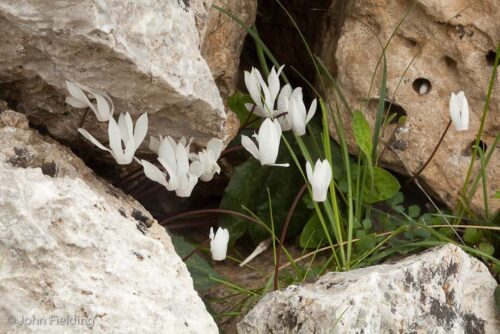
Cyclamen creticum
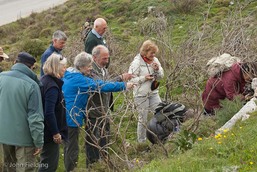
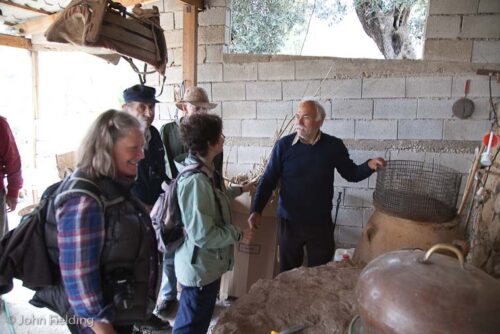
We had a long and pleasant lunch consisting of a range of local “mezes” at a taverna in Thronos. Taverna Aravanes is run by Lambros Papoutsakis, a very amenable fellow. With a wonderful array of local produce on sale there is also an emphasis on the local flora and fauna of which they are obviously proud.
Our book Flowers of Crete was open and in pride of place. On explaining that I was one of the authors the enthusiasm went up a notch or two and rakomelo was produced and offered around to numerous toasts. Rakomelo is a drink made from combining raki with honey flavoured with herbs or spices.
The view from the taverna is stunning, framed by the Psiloritis and Kedros mountains. Perhaps with the exception of the olive trees you could be in Devon.
After lunch we returned briefly to the Gious Kambos fields for more sumptuous orchids before returning back to Plakias.
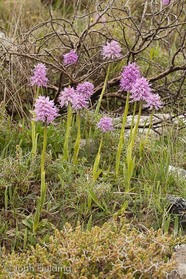
Orchis italica
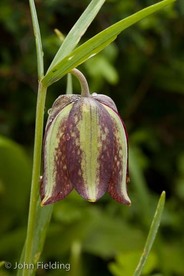
Fritillaria messanensis
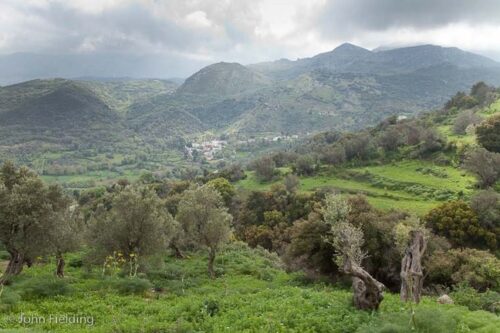
View from Taverna Aravanes
This was a walk to the hill above Aktounda and one or the villagers was very kind and ferried some of us up to the top to save our legs. Just below the start of the walk by the stream we found a nice patch of Cyclamen creticum. There was a sudden flash of black and white with pink – this was our only sighting of a hoopoe on this trip. Then it was uphill. Our climb was rich in orchid species – of particular note was Orchis simia and Orchis provincialis, both of which are not that common on Crete. On the top growing on relatively bare patches of soil were many of the distinct and rather attractive Trifolium uniflorum. Nearby were clumps of Aristolochia cretica growing in full sun with no protection from either shade or wind.
|
Plants noted:
Allium callimischon subsp. haemostictum Anacamptis boryi Anacamptis laxiflora Arisarum vulgare Asphodeline lutea Cyclamen creticum Euphorbia characias subsp. characias Euphorbia helioscopa Fritillaria messanensis Himantoglossum robertianum (syn. Barlia) Narcissus tazetta Neotinea lactea (syn. Orchis) Neotinea maculata Ophrys ariadne Ophrys bombylifera Ophrys cressa Ophrys heldreichii |
Ophrys mammosa |

Aktounda village, grapevines
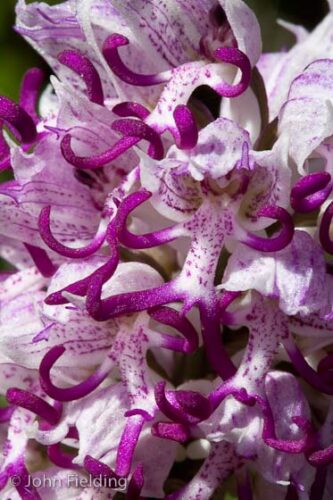
Orchis simia
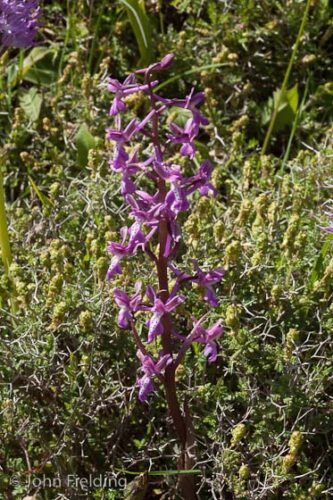
Orchis sitiaca
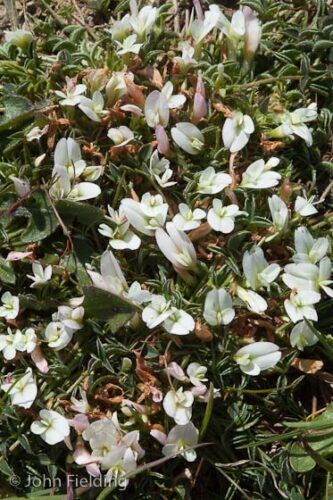
Trifolium uniflorum
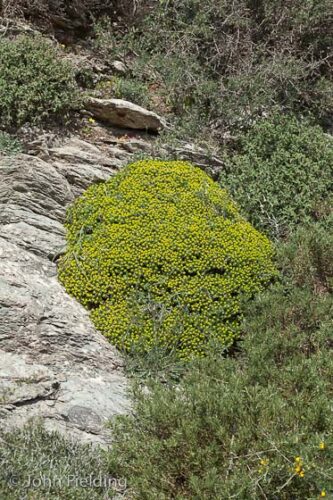
Euphorbia acanthothamnus
Plants noted:
Anacamptis boryi
Anacamptis collina
Anagallis arvensis
Aristolochia cretica
Calendula arvensis
Cyclamen creticum
Cydonia oblonga (quince)
Euphorbia acanthothamnus
Filago pygmaea (syn. Evax)
Himantoglossum robertianum (syn. Barlia)
Lathyrus setifolius
Ophrys ariadne
Ophrys iricolor
Orchis italica
Orchis provincialis
Orchis simia
Orchis sitiaca
Ornithogalum exscapum var. collinum
Oxalis pes-caprae
Rumex bucephalophorus
Sarcopoterium spinosum
Trifolium uniflorum

Quercus coccifera
Having had a picnic lunch at the village taverna we were shown around by a local couple. Next to the church was a large mature specimen of Quercus coccifera (Kermes oak) with a double trunk.
We drove towards Melambes and stopped by a stream where two spikes of Anacamptis laxiflora survived in the year-round moisture. Mentha spicata growing actually in the running water was proof that this stream never dries out.
Plants noted:
Anacamptis laxiflora
Cerastium comatum
Helichrysum conglobatum
Lupinus pilosus
Mentha spicata
Ranunculus asiaticus
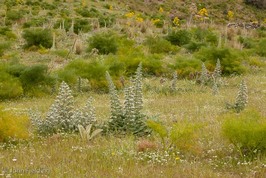
Echium italicum subsp. biebersteinii
We didn’t stay here long and headed for Saktouria where the coach wasn’t able to get through the village so our driver Manolis did an excellent three-point turn before we stopped at a likely looking west-facing slope to finish off the day.
Here we saw Stachys spinosa with its grey leaves and spines, but not in flower. The Echium italicum subsp. biebersteinii were in perfect flower and so beautiful and architectural – exquisite flowering cones in grey and soft, almost blue.
Anacamptis collina was quite common and the Aristolochia cretica again grew happily in the exposed environment. Not the first sighting, but in greater numbers than we had seen before were small drifts of the dark purple Linaria pelisseriana (Jersey toadflax).
In the early evening some of us assembled in a local bar for a pre-meal tipple. As we were looking out to the bay a flock of birds was approaching quite slowly and distinctly shaped. They were, I’m sure, squacco herons which I have seen on Crete before, and were presumably on migration

Paeonia clusii photo by Jo Hynes
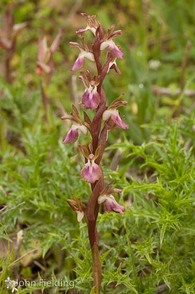
Anacamptis collina
Plants noted:
Acanthus spinosus
Anacamptis collina
Aristolochia cretica
Cistus creticus
Echium italicum subsp. biebersteiniiEchium plantagineum
Linaria pelisseriana
Ornithogalum exscapum var. collinum
Serapias bergonii
Stachys cretica
Stachys spinosa
Thursday 10 April
Roger and Jacki Foden were on Crete at the same time as us and gave us directions to find Paeonia clusii. This meant a reasonably long walk to a spot near to Alones, but it was worth it. They were absolutely superb, in full flower and smelling wonderful. Not surprisingly growing on this north facing site with them were Cyclamen creticum. Other plants growing alongside the road were the mauve coloured Ricotia cretica, rather like a dwarf honesty with seed pods that are also similar. Orchis quadripunctata was the most common orchid and Arum creticum was common too, even growing on top of a boulder.
|
Plants noted:
Acer sempervirens Arum creticum Charybdis maritima (leaves), (syn. Urginia/Drimia) Cyclamen creticum Erica arborea Fritillaria messanensis Lamyropsis cynaroides |
Orchis quadripunctata
Paeonia clusii Petromarula pinnata Platanus orientalis Pteridium aquilinum Ranunculus muricatus Ricotia cretica Sarcopoterium spinosum |
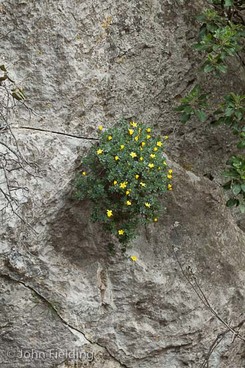
Linum arboreum
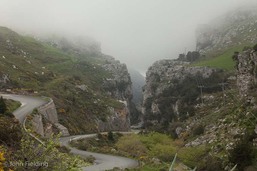
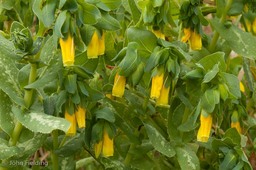
Cerinthe major
Plants noted:
Euphorbia characias subsp. characias
Ficus carica
Linum arboreum
Origanum dictamnus
Symphytum creticum (syn. Procopiana)
Verbascum arcturus
A walk down the Kotsifou Gorge started well enough and we were under the edge of the cloud sitting on the mountain. At the top Linum arboreum was hanging from the vertical cliff side of the gorge. Once in the gorge we were in the fog of the clouds and the wind whistling through the gorge made it really quite cold. It does have some interesting plants but we didn’t hang around and drove off to have a late lunch at Myrthios.
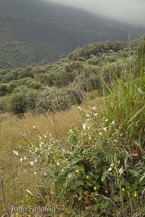
Salvia fruticosa
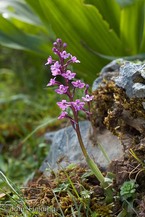
Orchis quadripunctata
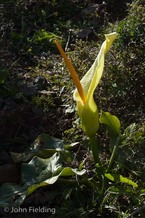
Arum creticum
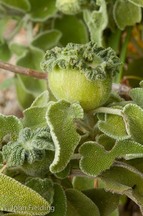
Salvia fruticosa gall
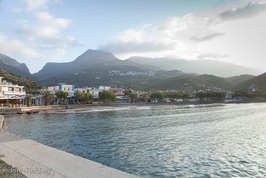
Plakios with Myrthios above
Our day ended with a pleasant stroll back to Plakias in the warm sun again with the clouds behind us. There was one specimen of Salvia fruticosa with pure white flowers, something I have come across in south central Crete quite often.
Plants noted:
Bellardia trixago
Cerinthe major
Cuscuta sp.
Euphorbia characias subsp. characias
Salvia fruticosa (including a white clone)
Scorzonera cretica
Securigera securidaca (syn. Coronilla)
Thymelea hirsute
Friday 11 April
Having packed and loaded up the coach we left Plakias and headed to the Imbros Gorge where we were joined by some of the members of the Crete branch of the Mediterranean Garden Society.
Compared to the Samaria Gorge this is about half the length at 8 kilometres with a drop of 650 metres. About seven of us took the rear position and soon started to botanise. The walk is said to take about two and a half hours and after about two hours of admiring and photographing many plants and views we wondered how far we might have travelled. Asking some of the people travelling up the gorge how much further we had to go the answer was another two hours! We upped the pace and indeed made it in four hours.
Living a relatively soft life in London with no gorges, screes or even rock to walk on I have to admit that some of us felt the after effects from the knees down. It is important to wear sensible shoes or preferably boots where there is walking on loose stones and boulders.
You currently have to pay €2 to enter the gorge which pays for a certain amount of maintenance and there are waste bins along the walk. There is an old mule trail paved with stones in the traditional way that used to provide the only access by land to Hora Sfakion before the modern road was built.
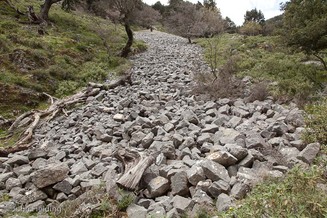
Top of Imbros Gorge

Scree, Imbros Gorge
At the top of the walk the habitat is dominated by Cupressus sempervirens and Acer sempervirens at least in terms of trees. The first orchid we saw was a lone specimen of Ophrys episcopalis though no orchid seemed to be common. Another was Orchis quadripunctata. Then we found an east-facing vertical rock face where many years ago I had seen Cyclamen graecum subsp. candicum, leaves only at this time of year. At least Jo Hynes, a national collection holder of the genus Cyclamen, had seen it. It was accompanied by the protected endemic Origanum dictamnus which is typically a chasmophyte (growing in rock crevices). The habitat alternated from open to deep shade under an evergreen canopy looking in part like an ancient forest on Dartmoor. Saxifraga rotundifolia subsp. chrysopleniifolia loves this deep shaded realm; the pristine, starry white flowers are occasionally finely spotted with red.
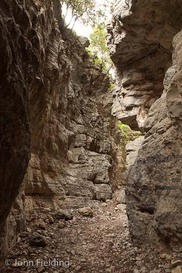
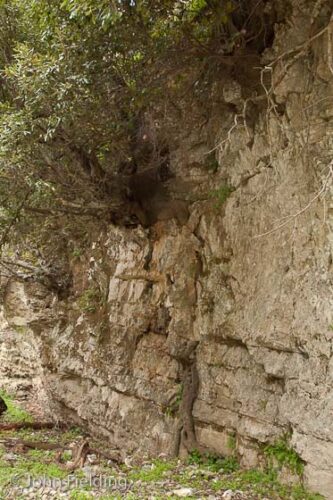
Quercus ilex in rock
About a third of the way down the gorge became deeper and the sides started to rise. Shaded cliffs were home to Quercus ilex (holm oak) growing as chasmophytes directly out of the cliff face, their huge roots in places defoliating the rock and exposed. This was followed by a scree of large rocks looking as if they had been quarried as they were quite uniform in size.
A stand of Ranunculus creticus was in full flower accompanied by the elegant leaves of Dracunculus vulgaris with their subtle white markings typical of Cretan forms, still not in flower at this altitude. In another shaded area where possibly a family had taken a picnic rocks and pebbles had been carefully stacked on every surface. Not just the boulders but also in the crooks of the trees.
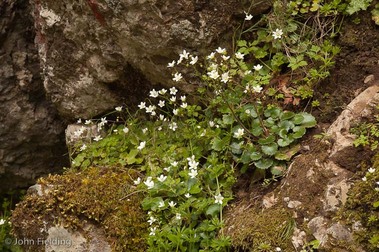
Saxifraga rotundiflora subsp. chrysopleniifolia
The gorge narrows several times with a minimum width of 1.6 metres. Despite being a smaller gorge than the Samaria it is dramatic with lovely rock strata. It was here that I noticed a pair of Celtis tournefortii (oriental hackberry) just coming into growth. Adiantum capillus-veneris (maidenhair fern) clung into the rock only in a few places where moisture permanently weeped out. There were yet more lovely specimens of the Linum at eye level and a few Athyrium felix-femina (lady fern), rare on Crete but common in the UK.
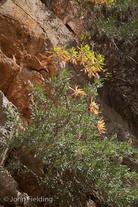
Euphorbia sultan-hassei
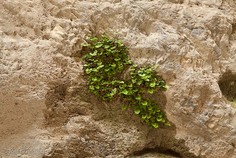
Adiantum capillus-veneris
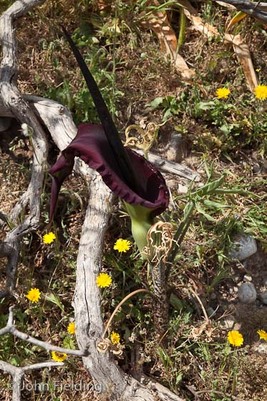
Adiantum capillus-veneris
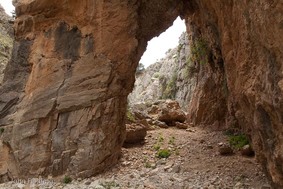
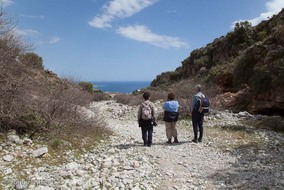
Bottom of Gorge
On leaving the gorge officially by having my ticket stamped at the exit kiosk I finally saw a few Dracunculus vulgaris in flower with their typical deep magenta black spathes and their tell-tale stench of rotting flesh. What an end to the walk! A beer (not my usual tipple) and a sit down to lunch in the shade of the local taverna with good company including the local MGS members was a welcome rest after a stunning walk.
Acer sempervirens
Adiantum capillus-veneris
Athyrium felix-femina
Celtis tournefortii
Cupressus sempervirens
Cyclamen creticum
Cyclamen graecum subsp. candicum
Dracunculus vulgaris
Euphorbia sultan-hassei
Linum arboreum
Ophrys episcopalis
Orchis quadripunctata
Petromarula pinnata
Quercus ilex
Ranunculus asiaticus
Ranunculus creticus
Rosularia serrata
Saxifraga rotundifolia subsp. chrysopleniifolia
Scrophularia peregrina
Symphytum creticum (syn. Procopiana)
Verbascum arcturus
Verbascum spinosum
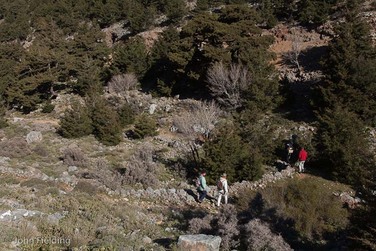
We then headed off to our second location for this trip staying on the Omalos plain.
Saturday 12 April
As the road leads out of the Omalos plain to the west and turns north there is a footpath, part of the E4 route, which cuts across the valley to the road south of Aghia Irini. It isn’t as far as the Imbros walk but already with aching legs it began to feel like it! The path for most of the distance was covered with loose stones making walking quite arduous and about a third of the way into the walk (which pretty much follows the road above to this point) you cross a scree.
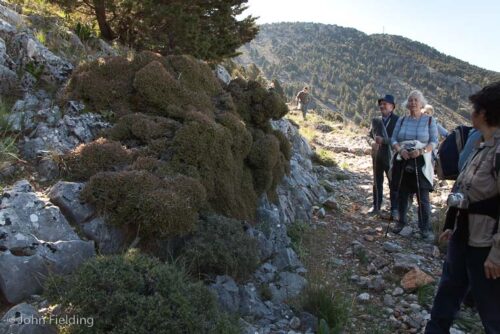
Quercus coccifera, goat grazed
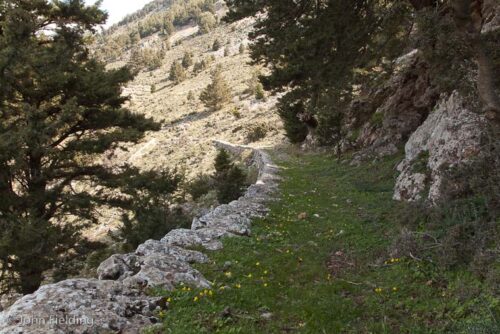
Ancient road Omalos to Irini
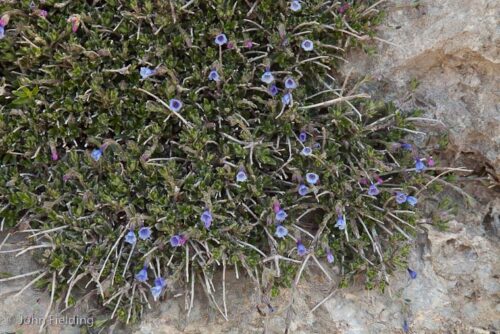
Lithodora hispidula

Omalos to Irini
Growing nearby was Onosma graeca, a biennial with very bristly hairs and drooping yellow tubular flowers. The track followed a ridge and almost disappeared into a sheep track where Chamaecytisus creticus was flowering with its yellow broom-like flowers on low, compact shrubs. Dotted through were the bicoloured flowers of Tuberaria guttata, a yellow rock rose with a chocolate brown centre. Many of the surrounding slopes were covered in abandoned terraces. With one last zigzag to the track we were down in the valley with a bridge over the river and the main road just above.
Plants noted:
Asphodelus ramosus
Berberis cretica
Centranthus calcitrapae
Chamaecytisus creticus
Cupressus sempervirens
Cyclamen creticum
Dracunculus vulgaris
Fumana arabica
Lamyropsis cynaroides
Lithodora hispidula
Onosma graeca
Orchis quadripunctata
Pteridium aquilinum
Quercus coccifera
Salvia pomifera
Sarcopoterium spinosum
Saxifraga rotundifolia subsp. chrysopleniifolia
Sedum amplexicaule
Tuberaria guttatus
Verbascum spinosum
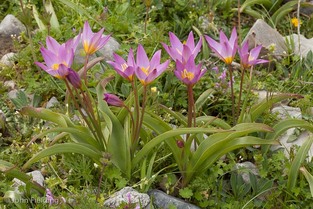
Tulipa saxatilis
After our picnic lunch we headed back into the Omalos plain and at the southern end near to the road to the head of the Samaria Gorge we headed into the fields dripping with Tulipa saxatilis. The drifts were in patches of varying hues which made them particularly attractive. Scattered through were also masses of Anemone coronaria, mostly in bluish purple tones but some were pinkish with the occasional red one too. Iris tuberosa (syn. Hermodactylis) was flowering everywhere, typically in its bicoloured form of a whitish tone with the black spot on the fall. There was an albino form with no black blotch. We found scattered tufts of Gagea chrysantha (hairless) which I originally assumed was Gagea peduncularis (hairy) with large bosses of yellow flowers. Also patches of the yellow flowered Ranunculus ficaria (lesser celandine). Certainly a highlight of the trip.
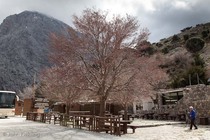
Zelkova abelicea
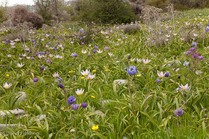
Anemone coronaria with Tulipa saxtalis
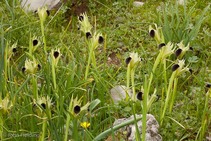
Iris tuberosa (syn. Hermodactylis)
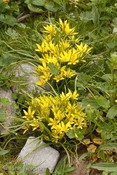
Gagea chrysantha
Anemone coronaria
Berberis cretica
Gagea chrysantha
Iris tuberosa
Lathyrus setifolius
Parentucellia latifolia
Ranunculus ficaria
Ranunculus gracilis
Tulipa saxatilis
A quick visit to the top of the Samaria Gorge entrance (closed until May) gave us a gorgeous view (pun). We saw the fine specimen of the endemic Zelkova abelicea in the car park and just about to flower. It is a splendid tree related to the elm and I think would make a fabulous tree in cultivation if it could be more widely grown. Its local name is “ambelitsa” and it is traditionally used for making walking sticks.
Some of our party had had enough of this splendid day and were dropped off at the hotel in the Omalos village while the rest of us drove on north for 10 minutes to walk up a track where Heather Martin and her husband Dick had seen Daphne sericea looking great in full flower. There was plenty of it here and in amongst the rest of the scrub were lots of Cyclamen creticum and Arum idaeum both in flower. The Arum, having small whitish spathes and, not typical for an Arum, a sweet scent. The specimen we found in flower was unfortunately rather eaten!
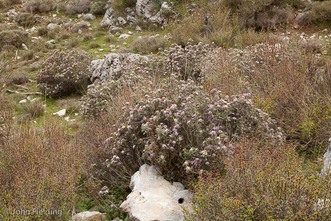
Daphne sericea
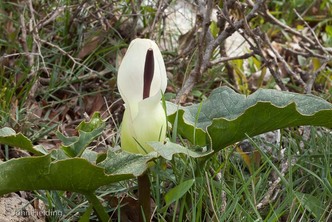
Arum idaeum
Acer sempervirens
Arum idaeum
Cyclamen creticum
Daphne sericea
Verbascum spinosum
Sunday 13 April
After our second night in Omalos I woke quite early to see the frost before the sun came up over the mountains.
We set off after breakfast for Chania airport on the Akrotiri peninsular. We had an hour at the Park for the Preservation of Flora and Fauna, part of the Technical University of Crete and quite near the sea. It was established in 1994 with the support of the Pancretan Endowment Fund and Yannis Phillis is the director. On arrival we managed to get everyone together for a group photo.

Frosty morning
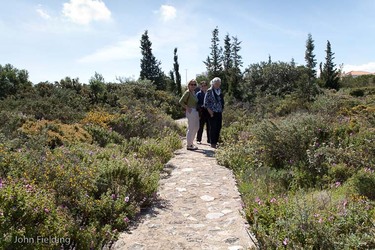
Park for Preservation
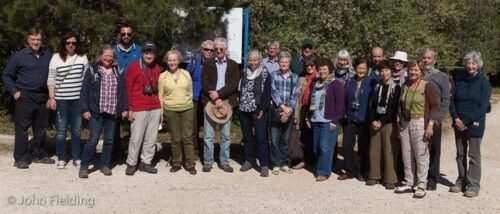
The Group
Plants noted:
Bellardia trixago
Ceratonia siliqua
Cistus creticus
Calicotome villosa
Echium italicum subsp. beibersteinii
Helichrysum conglobatum
Lavandula stoechas
Plants noted:
Bellardia trixago
Ceratonia siliqua
Cistus creticus
Calicotome villosa
Echium italicum subsp. beibersteinii
Helichrysum conglobatum
Lavandula stoechas
FULL LIST OF PLANTS NOTED:
Plants in family order, simplified into traditional groups. These are all plants seen and discussed (to at least some extent) on the trip.
Adiantum capillus-veneris
Athyrium felix-femina
Ceterach officinarum
Cheilanthes acrostica
Pteridium aquilinum
Selaginella denticulata
Woodwardia radicans
DICOTYLEDONS – A – F
Acanthaceae
Acanthus spinosus
Aceraceae (now Sapindaceae)
Acer sempervirens
Anacardiaceae
Pistacia lentiscus
Apiaceae (Umbelliferae)
Eryngium campestre
Ferula communis
Smyrnium perfoliatum subsp. rotundifolium
Aristolochiaceae
Aristolochia cretica
Asteraceae (Compositae)
Calendula arvensis
Centaurea calcitrapa
Centaurea idaea
Filago pygmaea (syn. Evax)
Glebionis coronaria (syn. Chrysanthemum)
Helichrysum conglobatum
Lamyropsis cynaroides
Phagnalon graecum
Picnomon acarna
Scorzonera cretica
Boraginaceae
Anchusa italica
Cerinthe major
Echium italicum subsp. biebersteinii
Echium plantagineum
Lithodora hispidula
Onosma graeca
Symphytum creticum (syn. Procopiana)
Brassicaceae (Cruciferae)
Nasturtium officinale
Ricotia cretica
Campanulaceae
Legousia speculum-veneris
Petromarula pinnata
Caryophyllaceae
Cerastium comatum
Silene gallica
Cistaceae
Cistus creticus
Cistus salvifolius
Fumana arabica
Fumana thymifolia
Tuberaria guttatus
Convolvulaceae
Convolvulus altheoides
Cuscuta sp.
Crassulacea
Rosularia serrata
Sedum amplexicaule
Cucurbitaceae
Ecballium elaterium
Euphorbiaceae
Euphorbia acanthothamnus
Euphorbia characias subsp. characias
Euphorbia dendroides
Euphorbia helioscopa
Euphorbia sultan-hassei
Ericaceae
Erica arborea
Erica manipulaeflora
Fabaceae (Leguminosae)
Bituminaria bituminosa
Calicotome villosa
Ceratonia siliqua
Chamaecytisus creticus
Ebenus creticus
Lathyrus setifolius
Lupinus albus
Lupinus pilosus
Medicago arboreus
Securigera securidaca (syn. Coronilla)
Trifolium uniflorum
Trifolium nigrescens
Vicia cretica
Vicia lathyroides
Vicia hybrida
Vicia sativa
Fagaceae
Quercus coccifera
Quercus ilex
Quercus pubescens
CONIFERS
Auraucaria excelsia
Cupressus sempervirens subsp. horizontalis
Pinus halepensis subsp. brutia
Dicotyledons continued
Lamiaceae (Labiatae)
Lavandula stoechas
Mentha spicata
Origanum dictamnus
Phlomis cretica
Phlomis fruticosa
Salvia fruticosa (including a white clone)
Salvia pomifera
Satureja thymbra
Stachys cretica
Stachys spinosa
Linaceae
Linum arboreum
Malvaceae
Malva sylvestris
Moraceae
Ficus carica
Oleaceae
Olea europea
Orobanchaceae
Orobanche crenata
Orobanche lavandulacea
Orobanche pubescens
Orobanche ramosa
Oxalidaceae
Oxalis pes-caprae
Paeoniaceae
Paeonia clusii
Papaveraceae
Glaucium flavum
Papaver argemone subsp. nigrotinctum
Papaver rhoeas
Platanaceae
Platanus orientalis
Polygonaceae
Rumex bucephalophorus
Primulaceae
Cyclamen creticum
Cyclamen graecum subsp. candicum
Ranunculaceae
Anemone coronaria
Anemone hortensis subsp. heldreichii
Ranunculus asiaticus
Ranunculus creticus
Ranunculus ficaria
Ranunculus gracilis
Ranunculus muricatus
Rosaceae
Cydonia oblonga
Sarcopoterium spinosum
Saxifragaceae
Saxifraga rotundifolia subsp. chrysopleniifolia
Scrophulariaceae (many now in Plantaginaceae)
Bellardia trixago
Linaria pelisseriana
Parentucellia latifolia
Parentucellia viscosa
Scrophularia canina
Scrophularia peregrina
Veronica anagallis-aquatica
Verbascum arcturus
Verbascum macrurum
Verbascum sinuatum
Verbascum spinosum
Solonaceae
Mandragora officinalis
Styracaceae
Styrax officinalis
Thymeleaceae
Daphne gnidioides
Daphne sericea
Thymelea hirsuta
Ulmaceae
Celtis tournefortii
Zelkova abelicea
Urticaceae
Urtica pilulifera
Valerianaceae
Centranthus calcitrapae
Valeriana asarifolia
Alliaceae
Allium callimischon subsp. haemostictum
Amaryllidaceae
Narcissus tazetta
Pancratium maritimum
Araceae
Arisarum vulgare
Arum concinnatum
Arum creticum
Arum idaeum
Dracunculus vulgaris
Asparagaceae
Asparagus aphyllus subsp. orientalis
Asphodelaceae (Liliaceae)
Asphodeline lutea
Asphodelus ramosus
Hyacinthaceae (Liliaceae)
Charybdis maritima (leaves), (syn. Urginia/Drimia)
Muscari comosum
Muscari spreitzenhofferi
Ornithogalum exscapum var. collinum
Ornithogalum narbonense
Iridaceae
Gladiolus italicus
Iris tuberosa
Moraea sisyrinchium (syn. Gynandriris)
Liliaceae
Fritillaria messanensis
Gagea graeca
Gagea peduncularis
Tulipa doerfleri
Tulipa saxatilis
Orchidaceae
Anacamptis boryi
Anacamptis collina
Anacamptis laxiflora
Anacamptis pyramidalis
Himantoglossum robertianum (syn. Barlia)
Neotinea lacta (syn. Orchis)
Neotinea maculata
Ophrys ariadne
Ophrys bombylifera
Ophrys cressa
Ophrys episcopalis
Ophrys heldreichii
Ophrys iricolor
Ophrys mammosa
Ophrys sicula (syn. O. phryganae)
Ophrys tenthredinifera
Orchis anthropophorum
Orchis italica
Orchis pauciflora
Orchis quadripunctata
Orchis sitiaca
Serapias bergonii
Serapias lingua
The following is a list of BIRDS by English names, we saw many other birds but these were the ones we noted.
Blackbird – Turdus merula
Common Buzzard – Buteo buteo
Cetti’s Warbler – Cettia cetti
Chaffinch – Fringilla coelebs
Crested Lark – Galerida cristata
Egyptian Vulture – Neophron percnopterus
Goldfinch – Carduelis carduelis
Great Tit – Parus major
Griffon Vulture – Gyps fulvus
Hooded Crow – Corvus cornix
Hoopoe – Upupa epops
Common Kestrel – Falco tinnunculus
Linnet – Carduelis cannabina
Raven – Corvus corax
Rock Dove (wild) – Columba livia
Squacco Heron – Ardeola ralloides
Stonechat – Saxicola torquatus
Swallow – Hirundo rustica
Wheatear – Oenanthe oenanthe
Wren – Troglodytes troglodytes

